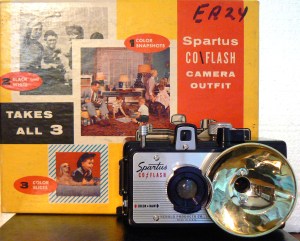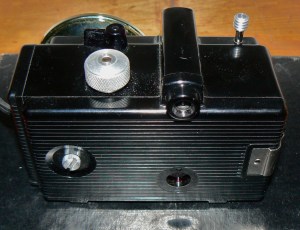
Falcon Press Flash, the first camera in my collection, acquired nearly fifty years ago
I have a soft spot in my heart for Falcon cameras, because, when I was about five years old, one of my mother’s coworkers gave me an old Falcon Press camera to play with. It was completely functional except for the flash, which didn’t work. I kept the camera, even after my parents gave me a fully working 620 rollfilm camera, which I used regularly throughout my childhood. In fact, the old Falcon is still in my collection, and certainly will be for as long as I am on this earth. After that, Sally can put it up on Ebay with all the rest of my junk!

My old Falcon with a near-identical Spartus Press Flash. Both were made c. 1939-50.
As mentioned in the previous post, Falcon was acquired by the company that made Spartus cameras, but the chronology is not clear to anyone, as far as I can tell. Utility Mfg. was the parent company responsible for all Falcons labeled as made in New York. Falcon Camera Company, apparently owned by Herold Products, was always shown as being in Chicago. Eventually, virtually identical Spartus and Falcon branded cameras were marketed to the same demographic. To make things more complicated, there were several other companies in Chicago and New York, who produced a number of surprisingly similar cameras under various labels. The 127 rollfilm cameras known as “minicams” were nearly identical in design, and several differ only in the name on the metal faceplate, yet they are labeled as having been manufactured by different companies. What they all have in common is a black or brown body made of cast plastic, usually bakelite or a similar material.

Minicams: Bullet, Photo Master, Beauta, Falcon Minicam, Photo Craft, and Falcon Miniature. The Art Deco Kodak Bullet is far and away the most elegant, and probably doesn't even belong in this group shot.
Minicams were really popular: they were small and pocketable, easy to operate, and they created either 12 or 16 exposures on a roll of #127 film. They were even more popular when 127 slide film came around, allowing them to produce “superslides” as large as 1-5/8″ x 2-1/2″. They have become a popular collectible because of the plethora of models available, and peripherally because most of them are made of bakelite. And one of the first and most popular of the minicams was the Kodak Bullet, an Art Deco torpedo with a spiral-threaded telescoping lens barrel. Designed by Walter Dorwin Teague, still the most famous industrial designer ever associated with cameras, the bakelite beauty was produced from 1936 through 1942. The plainer features reflected in the cameras shown above came in the post-war years, as Art Deco faded away and simple designs proliferated.
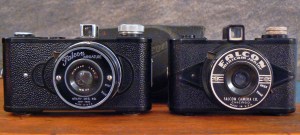
These Falcons were made c. 1947-50.
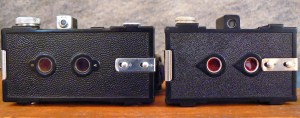
Twin red windows and internal masks facilitated 12 or 16 exposure formats
But Kodak’s competitors weren’t completely lacking in artistry. The cute little Spartus Folding Camera, circa 1940-50, is all bakelite with chrome detailing and an Art Deco look similar to that sported by many Kodak products. It would have competed with the Vest Pocket Kodaks as well as the minicams, although the VP’s were considerably smaller.
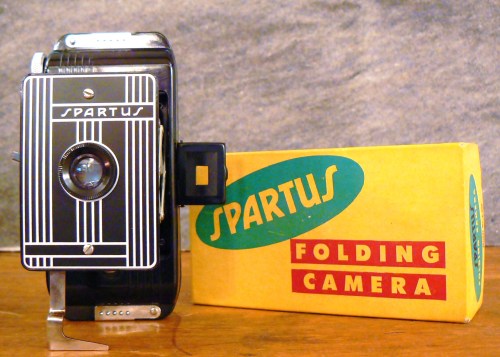
Spartus Folding Camera. This specimen is in mint condition with the original box.


